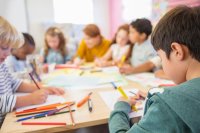Supporting Students Affected by Trauma
Just as students with learning challenges need academic accommodations, students who have adverse childhood experiences may benefit from social and emotional accommodations.
Your content has been saved!
Go to My Saved Content.If our schools are to address the severe life disruptions and trauma that are occurring in our student populations, we need to be authentically trauma responsive and advocates of social and emotional learning. That is a path to improving our students’ learning outcomes and competencies—unless students feel safe and known in school, they do not learn.
Students who come to school dysregulated cannot access the executive functions they need to pay attention, emotionally regulate, problem-solve, hold strong memory, and be creative. Luckily, there are accommodations that help students with adverse childhood experiences (ACEs) calm their stress response systems so they can access executive functions. And because our students spend thousands of hours in school during their K–12 years, educators have the opportunity to address social and emotional competencies by using these accommodations that are so needed for the emotional, social, and cognitive well-being of our students who carry in adversity and trauma.
Many of our students who need emotional support and resources do not have an IEP or 504 or a team of educators and staff available to consistently meet their social and emotional needs each day. These students have critical needs in the areas of attachment and self-regulation, and educators can do much to support them, even in the absence of an IEP or 504, by working to build relationships with them throughout the school day, fostering a much-needed sense of attachment to the school community.
Secure attachments and strong relationships help these students develop their nervous systems and brains and build the skills needed for emotion regulation.
Discipline Instead of Punishment
We can build these relationships and attachments by intentionally and transparently handling these students with care and understanding, and employing these accommodations within our procedures, routines, transitions, and morning bell work and meetings.
We can also keep in mind the difference between discipline and punishment. Pain-based behaviors can look disrespectful, aggressive, oppositional, defiant, or dissociated and shut down. When these behaviors cause harm, they shouldn’t be excused, but we should use discipline rather than punishment. Discipline means providing the practices and strategies students require to feel calm, focused, and ready to learn. Once they’re calm, it’s possible for them to learn from the harm they have caused.
We don’t get angry with students who need academic accommodations when we provide graph paper, extra time on an assignment, audio or technology accommodations, or adjustments on an assignment. Students with ACEs need the experiences and opportunities that will help them improve their self-regulation and connection—they need SEL accommodations, and focusing on discipline rather than punishment helps educators give students the guidance they need, without anger.
Accommodations for Students With Trauma
At the district, school, department, grade, or classroom level, we can create these accommodations for our students who walk in ready to fight, flee, or shut down.
A change of seating arrangements can sometimes help a student feel safe and focused. This placement or seat may need to be in the back of the classroom or against a wall so there is a felt support and the student can see everything around them and in front of them.
This next step takes some work: Educators start by identifying students coping with ACEs—looking at chronic discipline issues can help educators know which students need a sense of connection and help with self-regulation. For each of these students, identify one or two adults in the school with whom the student feels comfortable and safe. This kind of mentor relationship is a touchpoint in times of anxiety or dysregulation, and a powerful accommodation that provides a sense of safety for self-regulation and secure connection.
Meeting with this mentor every week provides an opportunity for a check-in, during which students can share and discuss their challenges and successes. Discussions might cover points like these:
1. Strengths to Help Me With My Goals
- I love to learn. I’m seen as a leader and good friend by others.
- I have a great imagination.
- I notice everything.
- I am good at sensing others and nonverbal communication.
2. Interests and Areas of Expertise
- I love art.
- I am interested in animals, especially cats.
- I have a pet-sitting service.
- I am good at soccer.
3. Triggers
- What are some experiences, events, sights, sounds, smells, relationships, or people that cause you to feel anxiety or other negative emotions?
Another idea is to set up a personalized routine of self-regulation accommodations before there are conflicts and behavioral challenges. For example, start with a list of quick breaks—getting a sip of water, taking a walk, taking three deep breaths, drawing or using a favorite art form, moving to a quiet area, or journaling—and have the student choose two or three items from the list that they will employ in times of dysregulation and growing frustration.
It is key that these steps be taught and discussed ahead of time so that when the student does get upset, they don’t have to make a tough decision about what to do—they have only two or three choices, which they selected for themselves in a moment of calm.
